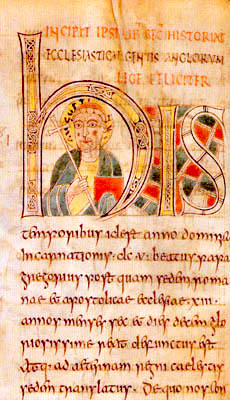Saint Petersburg Bede facts for kids
The Saint Petersburg Bede is a very old and special book from Anglo-Saxon times. It's an illuminated manuscript, which means it's a handwritten book with beautiful decorations and pictures. This book contains a copy of a famous history written by a monk named Bede in the 8th century. His book is called Historia ecclesiastica gentis Anglorum, or Ecclesiastical History of the English People.
The Saint Petersburg Bede is famous because it has the earliest known historiated initial in European art. A historiated initial is a large, decorated letter at the start of a section that contains a picture inside it. The book got its name because it was taken to the Russian National Library in Saint Petersburg, Russia, during the time of the French Revolution.
How Old Is This Special Book?
Experts believe the Saint Petersburg Bede was made at Bede's own monastery in Wearmouth-Jarrow. They use a method called palaeography, which is the study of old writing, to figure this out.
The book was likely copied sometime between 731 and 746 AD. This means it was made not long after Bede finished writing his history. While it's hard to know the exact year, it's clear the book is very old, probably from the middle of the 8th century.
What Does the Book Look Like?
This ancient book is written on parchment, which is a special material made from animal skin. It has 162 pages, called folios. Each page is about 270 by 190 millimeters (about 10.6 by 7.5 inches). The writing area on each page is smaller, about 230 by 150 millimeters, and has two columns of 27 lines.
Several different people copied the text in the book. There was also a fifth person who added things like chapter numbers and notes.
The first three letters of Book 2 of Bede's history are beautifully decorated. The first letter, an 'h', is very special. It has a small picture inside it of a saint with a halo. This saint is holding a cross and a book. People think it might be St. Gregory the Great, or perhaps St. Augustine of Canterbury. You can tell it's a saint and not Jesus because the figure has a clerical tonsure, which is a special haircut worn by monks. The decorations in the book show a mix of local Anglo-Saxon styles and influences from the Mediterranean region.
What's Inside the Saint Petersburg Bede?
The Saint Petersburg Bede contains one of the two oldest copies of Bede's Latin Historia ecclesiastica. This is a very important historical record of the early English church and people.
The book also holds a rare copy of an old English poem called Cædmon's Hymn. This poem is written in the bottom margin of one of the pages. It's a very early example of English poetry.



